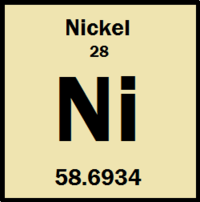Nickel

Nickel is the 28th element on the periodic table. Nickel is found naturally in the Earth's crust, with most of the world's nickel supply being mined in the Philippines and Indonesia. Other countries producing vast amounts of nickel include Australia, Russia and Canada.[2] Nickel was discovered in 1751 by Axel Fredrick Cronstedt.
In addition to being good for making magnets[3] (Nickel is one of five elements that are ferromagnetism), other properties of nickel include:[4]
| Atomic weight | 58.6934 |
| Density (at 0oC) | 8.912 g/cm3 |
| Boiling point | 3186 K |
| Melting point | 1728 K |
Uses
Nickel is a silvery metal that resists corrosion even at high temperatures. Due to this property, it is used to plate other metals in order to protect them.[4]
Nickel is mainly used in the production of alloys such as stainless steel. Another alloy is Nichrome, which combines nickel with chromium, and small amounts of silicon, manganese and iron. Nichrome is used in toasters and electric ovens as it resists corrosion even when it is red-hot.[5] Nickel alloys are also used in the making of turbines, see below.
Nickel is used in types of batteries, notably rechargeable nickel-cadmium batteries and nickel-metal hydride batteries used in hybrid cars (see below).[5]
- Nickel is used in turbines and batteries
Video
The video below is from the University of Nottingham's periodic videos project.[8] They have created a complete suite of short videos on every element on the periodic table of elements.
References
- ↑ Made internally be a member of the Energy Education team, with information from periodictable.com, Available: http://periodictable.com/Elements/008/index.html
- ↑ USGS. (accessed August 30, 2016). Mineral Commodities Summary 2015, page 112, [Online] Available: http://minerals.usgs.gov/minerals/pubs/mcs/2015/mcs2015.pdf#112
- ↑ Hyperphsics. (Accessed September 3rd, 2016). "Ferromagnetism [Online], Available: http://hyperphysics.phy-astr.gsu.edu/hbase/solids/ferro.html
- ↑ 4.0 4.1 Jefferson Labs. (Accessed July 7, 2016). The Element Nickel [Online], Available: http://education.jlab.org/itselemental/ele028.html
- ↑ 5.0 5.1 Royal Society of Chemistry. (Accessed July 7, 2016). Nickel [Online], Available: http://www.rsc.org/periodic-table/element/28/nickel
- ↑ Wikimedia Commons [Online], Available: http://en.wikipedia.org/wiki/Transport#/media/File:NYC_Subway_R160A_9237_on_the_E.jpg
- ↑ Wikimedia Commons [Online], Available: https://en.wikipedia.org/wiki/Nickel%E2%80%93cadmium_battery#/media/File:NiCd_various.jpg
- ↑ See more videos from the University of Nottingham on different elements here: http://www.periodicvideos.com/


![[6]](/wiki/images/thumb/2/24/Nickel_based_TrentTurbineBlades.jpg/435px-Nickel_based_TrentTurbineBlades.jpg)
![[7]](/wiki/images/thumb/4/41/NiCd_various.jpg/462px-NiCd_various.jpg)